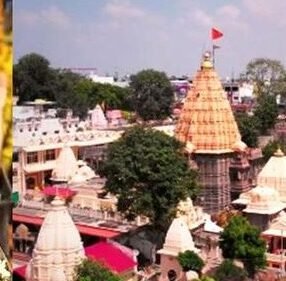
Prince Kumarasena was appointed by King Chanda Pradyota in the 6th century. BC to look after the law and order situation of the Mahakal temple. Punch-marked coins of Ujjain, 4th-3rd c. BC, put on them the figure of Lord Shiva. The mention of the Mahakal temple is also found in many ancient Indian poetic texts. According to these texts the temple was very grand.
Its foundation and platform were made of stones. The temple rested on wooden pillars. Before the Gupta period there were no shikharas on the temples. The roofs of the temples were mostly flat. Probably for this reason Kalidasa in Raghuvansham has called this temple ‘Niketan’. Near the temple was the palace of the king. In the opening part of the Meghadootam (formerly the Cloud), Kalidasa gives a fascinating description of the Mahakal temple.
It seems that this Chandeshwar temple must have been a unique example of art and architecture of the time. It can be estimated from this how magnificent the temple of the main deity of that city must have been, with multi-storey gold plated palaces and buildings and magnificent artistic grandeur. The temple was surrounded by a high rampart attached to the entrance. At twilight, vibrant rows of lit lamps illuminated the temple complex.
The whole atmosphere reverberated with the sound of various musical instruments. The attractive and well decorated maidens added a lot to the beauty of the temple. The echo of the Jai-Dhoni (Victory to God) of the gathering of devotees was heard far and wide. The priests were busy in worshiping and praising the deity. Vedic hymns were recited and praises sung, painted walls and well-carved images projected the artistic heights of the day.
After the decline of the Gupta Empire, several dynasties including the Maitrakas, Chalukyas, later Guptas, Kalachuri, Pushyabhuti, Gurjara Pratiharas, Rashtrakutas, etc. dominated the political scene in Ujjain one after the other. However, everyone bowed before Mahakal and distributed alms and alms to the deserving ones. Several temples of various deities, shrines, kundas, vapis and gardens took shape in Avantika during this period.
Many Shaivite temples including 84 Mahadevs were present here. This fact should be particularly underlined that while every nook and corner of Ujjain was dominated by religious monuments bearing images of their respective deities, the development and progress of the Mahakal temple and its religious cultural milieu was not neglected at all .
Among the many poetic texts composed during this period, which sing the significance and glamor of the temple, Banabhatta’s Harascharita and Kadambari, Sri Harsa’s Naishadcharita and Padmagupta’s Navasahamacharita are notable. It appears that during the Parmar period, a series of crises prevailed over Ujjain and the Mahakal temple. In the eleventh to the eighth decade of C.E., a Ghaznavi general invaded Malwa, ruthlessly plundered it and destroyed many temples and images.
But very soon the Parmars made everything new. A contemporary Mahakal inscription testifies to the fact that during the later eleventh c. And in the early twelfth century, the Mahakal temple was rebuilt during the reigns of Udayaditya and Narvarman. It was built in the Bhumija style of architecture, which was very much liked by the Paramaras. The remains available in the temple complex and nearby places attest to this fact. The temple plan of this style had either Triratha or Pancharatha.
The main distinguishing feature of such temples was its star-shaped plan and spire. As far as the summit is concerned, the Urusang (mini-spire), usually of odd numbers, gradually decreasing in size in rows between the well-decorated spines (Haravali or Lata) from the cardinal points from the Chitya and Sukanasa But got up. Crossed by Amalaka. Every part of the temple was decorated with ornamental motifs or images.
Horizontally, the temple was divided from front to back into entrance, ardhamandapa, sanctum sanctorum, antarala (vestibule) sanctum sanctorum and pradakshanapatha respectively. The upper parts of the temple are supported by strong and well designed pillars and pillars. Such temples, according to contemporary Shilpa-shastras, included images of various gods and goddesses, Navagrahas (nine planets), Apsaras (celestial girls), female dancers, anachrons (attendants), kichakas, etc.
The sculpture art of the temple was very classical and varied. Apart from the Shaiva images of Nataraja, Kalyanasundara, Ravananugraha, Gajantak, Sadashiva, Andhakasur-Vadh, Lakulisa etc., the temples were decorated with images of Ganesha, Parvati, Brahma, Vishnu, Surya (the sun-god), the Sapta matrikas (seven). Mother Goddess) etc.
These images were very proportionate, well decorated, sculptural and engraved according to classical and mythological texts. The conduct of worship and rituals continued in some form or the other. Prabandha Chintamani, Vividh Teerth Kalpataru, Prabandha Kosh all were composed during the 13th-14th century. Reveal this fact. Similar mention is found in Vikramcharita and Bhojcharita composed in the 15th century. AD Epic Hammira According to the epic, Hammira, the ruler of Ranthambore, worshiped Lord Mahakal during his stay in Ujjain.
Some sanads issued by the Sultans of Malwa and the Mughal emperors have surfaced in Ujjain which testify that during the medieval period these Islamic rulers made certain offerings to the priests to worship, light lamps and pray for the protection of divinity. had donated. His rule.
Thus it is clear that Mahakaleshwar was respected even among these Islamic rulers and also issued financial aid for appeasement of Hindu subjects. Maratha rule was established in Ujjain in the fourth decade of the eighteenth c.
The administration of Ujjain was entrusted by Peshwa Bajirao-I to his loyal general Ranoji Shinde, the Diwan of Ranoji was Sukhankar Ramchandra Baba Shenvi who was very rich but unfortunately ruthless. On the suggestions of several learned punds and well-wishers, he decided to invest his wealth for religious purposes. In this connection he rebuilt the famous Mahakal temple at Ujjain during the fourth-fifth decade of the eighteenth century.
84 shrines have resided in the Mahakaleshwar temple Mahadev in Ujjain

